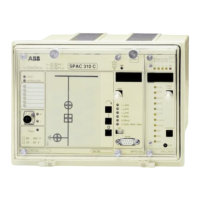8
Control functions
General
The control module SPTO 1D2 is used for
reading the status information of circuit-break-
ers and disconnectors.The module indicates the
status locally by means of LED indicators and
transfers the information to station level equip-
ment via the SPA bus. The status of maximum
three objects can be indicated.
The control module is also used for controlling
one object e.g. a circuit-breaker, locally or with
the opening or closing commands received over
the SPA bus.
In addition to status information the control
module can read other binary data, indicate the
information locally and transfer it to station
level equipment. Maximum six external binary
signals can be wired to SPAC.
Input channels 1…3 The control module uses input channels 1…3
to read the status information of circuit breakers
and disconnectors. Each of these channels is
formed by two binary inputs, one input is used
for reading the open status and the other one for
reading the closed status of an object. This
means that the status information must be wired
to SPAC as four-pole information.
The front panel of SPTO 1D2 has a 4x4 matrix
of status indication LEDs. Simultaneously,
maximum three of these LEDs can be used for
status indication. The circuit breaker/discon-
nector configuration indicated by these LEDs is
freely programmable by the user.
One of the objects whose status is read via input
channels 1…3 can be controlled. This is done
by using the outputs OPEN and CLOSE.
Input channels 4…9
and 10…13
The control module can be used for reading six
external and four internal binary signals. The
external signals, channels 4…9, can be single
contact data wired from the bay and the internal
signals, channels 10…13, are startings and trip-
pings of the protection.
The input signal type for channels 4…13 can be
programmed to be active at high state, i.e.
normally open contact, or active at low state, i.e.
normally closed contact.
The front panel has a local LED indication for
the external input channels 4…9. The red LED
is lit when the input is active.
The input channels 4…13 can be used to con-
trol the outputs OPEN, CLOSE and SIGNAL
1…3. If the input channel becomes active the
programmed OPEN or CLOSE output gives a
pulse. The output SIGNAL 1…3 is active as
long as the input is active.
Interlocking The control module includes a feeder-based
interlocking which is freely programmable by
the user. When writing an interlocking program
the user defines when it is allowed to give an
open or close pulse for the controlled object.
When an opening or closing command is given
the interlocking is checked and after that the
command is executed or canceled.
The interlocking can be programmed to be
depending on the status of the four-pole input
channels 1…3 and the status of input channels
4…13. The tripping signals of the protection
are not influenced by the interlocking.
To simplify start-up the feeder terminal is pro-
vided with default interlocking schemes. A de-
fault interlocking scheme is always related to a
default circuit breaker / disconnector configura-
tion.
Conditional direct
output control
Normally the OPEN and CLOSE outputs are
controlled by giving an open or close command.
In the conditional direct output control all the
outputs, i.e. OPEN, CLOSE and SIGNAL 1…3,
can be controlled without using an open or close
command. The outputs are activated depending
on a programmed logic and the status of input
channels 1…3 and 4…13.

